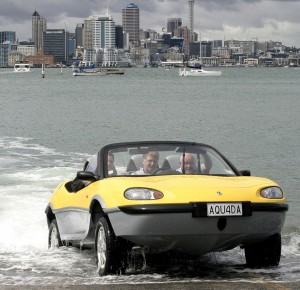Making a vehicle amphibious would cost a premium of just 15% if it were designed for water use from the start, the chairman of the company that is working on several amphibious vehicles said.
In an exclusive interview with TheDetroitBureau, Neil Jenkins, chairman of Gibbs Technologies, said the additional hardware needed to turn a garden-variety car into an High-Speed Amphibian is not excessive. Added equipment would include a water jet with a power takeoff from the engine, the hardware to raise the wheels out of the water, sensors to allow the vehicle to determine it is floating and marine lights. That would turn a $32,000 Ford Mustang convertible into a fast amphibian priced at less than $37,000.
So far, the company’s biggest challenge has been winning U.S. regulatory approval for the car, called the Aquada, that Gibbs wants to build. In fact, Jenkins admitted that he figured getting the Aquada into production would take about three years, not the 11 years since he signed on with the company.
Gibbs is currently developing several other amphibious vehicles including military and first-responder vehicles and other projects that have not been specified. The first product to market will be the Quadski, which is sort of a cross between an all-terrain vehicle and a personal watercraft. Prototype production begins later this year with volume production expected to begin in the second quarter of 2011, Jenkins said.
Click here for an exclusive look at the Quadski.
Many experts have questioned whether there is a sizable market for amphibious vehicles, but Jenkins said the true measure will be how the technology impacts the lives of people. When most people think about amphibious vehicles, they think about the mid-’60s Amphicar, which was limited to just 7 mph in water and wasn’t a very good car out of it, or World War II-era amphibious transport vehicles that many tour groups around the country still use for sight-seeing tours.
“I agree with (critics), those vehicles have a very limited market,” Jenkins said. “High-Speed Amphibians have a whole new level of interest.”
Gibbs has given test rides in the Aquada prototype, which is capable of traveling more than 100 mph on land and 30 mph in water. The company has promised that production versions will be even faster, hitting 40 mph on water when it is powered by a larger engine.
Jenkins said the company has had trouble doing its own market research because people have a difficult time grasping the concept of a car that is also a full-fledged boat.
Representatives of two other amphibious vehicle companies think Gibbs’ predictions that it could sell 10s of thousands of Aquadas – a prediction that Jenkins repeated last week – are all wet.
Both Fred Selby of WaterCar in southern California and John Giljam of Cool Amphibious Manufacturing Inc. (C.A.M.I.) believe the market may top out in the hundreds per year. WaterCar, based in Southern California, wants to build a “turn-key” minus kit amphibian called the Python where the owner install the powertrain. C.A.M.I. builds the HydraSpyder, but will not sell it in the U.S.
Click here for an in-depth look at the potential market for amphibious vehicles.
So far, Gibbs has been privately funded, but how much money the company has spent developing its vehicles is unknown. As recently as three years ago, Jenkins said that the company had spent $100 million to date, but has declined to say how much it has spent since then. That said, Jenkins has in the past made it clear that there is plenty of funding available for the company’s projects. The company has averaged about 70 people on staff during the last several years.
The company was founded in 1996 by Alan Gibbs, a New Zealand industrialist, who later took Jenkins, a specialist in developing lightweight vehicles, as a partner.
Jenkins admitted that there would really be no way to develop High-Speed Amphibian technology without intensely private funding. It’s too risky for the big automakers or even venture capitalists.
“Alan Gibbs is an absolute visionary,” Jenkins said.
Besides the extra hardware required to turn a car into a fast amphibian, designers would also have to shape the underside and wheel wells for water use and use different seals for doors and holes in the body required for wiring and controls. Those items would be different, but not significantly more expensive, Jenkins said.

